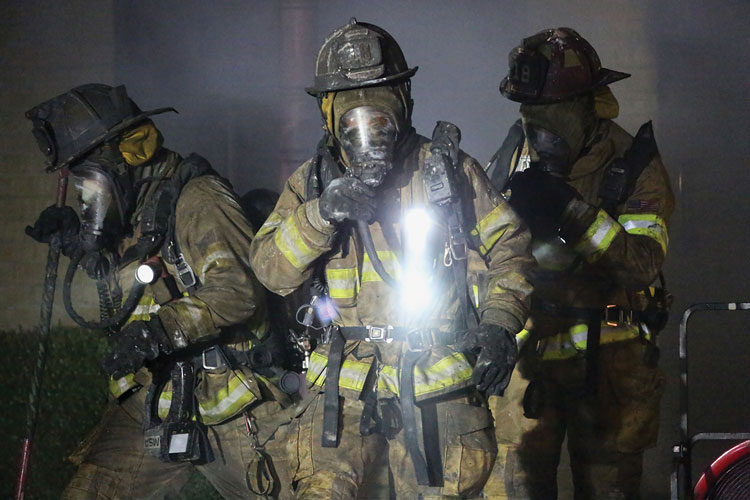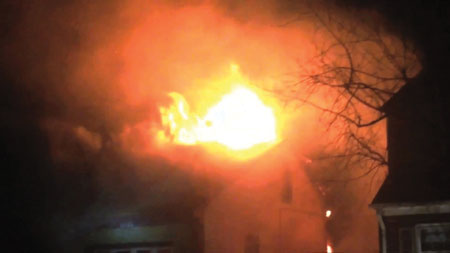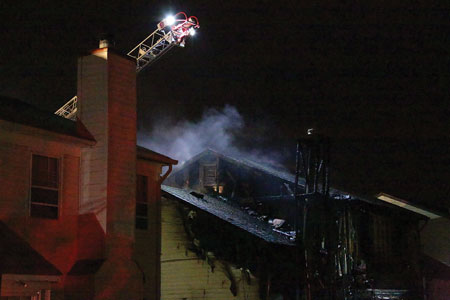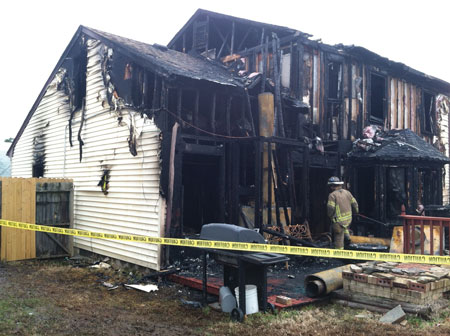
BY JONATHAN A. RIGOLO
On January 16, 2014, the Virginia Beach (VA) Fire Department (VBFD) responded to a well-advanced and fast-moving single-family structure fire that challenged first-arriving officers and crews. Two civilians perished and one was injured. Four firefighters were also injured, and two experienced a near miss while conducting the vent-enter-isolate-search (VEIS) tactic.
 |
| (1-4) Photos by the Virginia Beach (VA) Fire Department. |
Because of the decision to use the high-risk VEIS tactic, the VBFD reviewed and discussed the decisions made on the fireground that evening. What went right? What could the officers and crews do to improve? The fire service will risk a lot to save a lot, as did the VBFD that evening. The department wants to share the officers’ decisions and actions with the goal to improve fireground decision making in the fire service.
Initial Response
The incident occurred in the Salem Woods section, which is densely populated with single-family detached and multifamily attached Type V wood-frame buildings. Because of this density, vehicles are parked on the street, and access to the front of the structures is limited to a few apparatus.
Battalion 3; Engines 18, 23, and 9; Ladder 9; and Squad 10 (a rescue company) were dispatched to a reported structure fire. En route, the dispatcher updated with a report of people trapped. An additional update said several callers reported a large fire and that people were trapped.

The initial call was dispatched at approximately 1801 hours. The dispatcher comments included a report of heavy fire at the rear of the structure and a report of people trapped. En route, units received several updates including additional reports of people trapped on the second floor of the occupancy.
The structure involved was a two-story, single-family dwelling of wood-frame construction with vinyl siding as the exterior finish. The house occupied approximately 1,800 square feet. The fire was accidental and started in the zero clearance fireplace chimney chase on the exterior wall of the structure’s Charlie side (photo 1).

An officer and three firefighters staffed E-18, the first fire unit on scene. The initial size-up reported heavy smoke and fire showing on the Charlie side. As per policy, E-18’s officer established a mobile command. After his 360° walk-around, he reported that about 50 percent of the Charlie side exterior was involved. A 1¾-inch handline was stretched to the structure’s front door. The crew began an interior attack but could only make it about five feet into the structure because of the high heat (photo 2). The company remained at the front door attempting to “hold” the interior stairs for Squad 10 (S-10, now Rescue 2) that was now arriving. I was the captain of S-10.
The next arriving unit, E-23, established a water supply for the attack engine and stretched a 2½-inch handline to the Charlie side of the structure. E-23’s officer established a formal command and directed S-10 to attempt VEIS at the Delta side second-floor window. E-23’s officer encountered several police officers who confirmed reports of occupants trapped on the second floor.
Making Entry
The additional assist units began arriving. On L-9’s arrival, the driver immediately began throwing ground ladders; the officer and jump seat firefighter intended to begin searches on the first floor but were unable to enter because of high heat and fire on the first floor. E-9 arrived next and was assigned to assist with stretching the hoselines to the Charlie side. My company (S-10) arrived but had to park a block from the scene because of congestion caused by earlier responders, including the police. S-10 approached the fire scene; at the front of the house, command ordered us to conduct a VEIS on the Delta side, second floor. L-9’s driver, carrying a ladder, was walking past me when command gave the VEIS order; the L-9 driver was directed to place the ladder at the second-floor window on the Delta side (photo 3). The S-10 jump seat firefighter and I donned our self-contained breathing apparatus (SCBA) face pieces and began the VEIS operation. The firefighter went up the ladder and cleared the window, and heavy smoke began pushing from the structure.

He sounded the floor and began to make entry but was driven back by a blast of heat so intense that he said it felt as if his hood was not on properly. He was directed to come down the ladder. As the S-10 officer, I ascended the ladder, sounded the floor, and entered the room. Note that at this point conditions in the room had improved – the smoke was dark and was not charged or pushing from the structure at this time. When I entered the room, I again sounded the floor, noting a weak floor toward the Charlie side and a small amount of fire near the knee wall, which was also on the Charlie side. I was unable to locate an interior door to isolate the room. (I later found out that the door to the bedroom was down at the bottom of a set of stairs to the first floor.) I began a search of the room using a thermal imaging camera (TIC). Conditions were hot, yet tenable. The initial firefighter came back up the ladder and entered the room behind me – I directed him to stay at the window while the VEIS was underway.
Flashover!
I located a victim at the foot of a bed toward the Alpha side of the room, and the firefighter and I moved the victim toward the Delta window where we handed the victim off to a third firefighter who was on the ladder. During this time, the room became noticeably warmer, yet it was still tenable. After handing the victim off, I started to move back into the room to search for a reported second victim. The firefighter hit my SCBA to alert me that he needed to get out. Note that this firefighter was more than six feet tall, so he was absorbing a tremendous amount of heat. I told him to get out. About 30 seconds after the firefighter bailed, I also decided it was time to leave. The room’s conditions had quickly deteriorated to the point where I could feel pain and burning through my gear. As I was moving toward the Delta side window to leave, the room flashed over, and I was engulfed in flames. All I could see was orange in the entire room (photo 4).
 |
| (5) Photo by Rayford Smith. |
At this point, an unusual thought entered my mind. In the brief moments of deciding what to do and where to go, I had an overwhelming desire to go deeper into the room, perhaps to retrieve the handlight, TIC, and tool I had left on the bed. Fortunately, I chose to bail out of the window. I could not see the window, but I had an idea of where it was and made a leap toward the opening. Again, fortunately, I chose wisely and exited the window surrounded by fire. The first firefighter who had exited had the presence of mind to jump off the ladder after exiting to make room for me, hoping that I would soon follow him. After exiting the room, I fell from the ladder, but several firefighters had their arms raised and cushioned my fall to the ground. On the ground, I was wet down with a hoseline and assisted in removing my gear. Both the firefighter and I suffered burns over various parts of our bodies and were transported to a local hospital, where we were treated for first- and second-degree burns and released late that evening.
Sadly, the victim was pronounced dead soon after being removed from the structure. A second victim, deceased, was located and removed after the fire was extinguished. One walking-wounded victim was discovered around the same time the VEIS was underway. This victim was transported to the hospitial in critical condition and survived.
 |
| (6) Photo by Rayford Smith. |
After completing the VEIS, the firefight transitioned from offensive to defensive because of the deteriorated conditions and the presence of holes in the floors. Photo 5 shows the Delta side after extinguishment; photo 6 shows the Charlie side the next day.
Lessons Learned
What Went Right
- The basics were performed brilliantly: Handlines were promptly stretched and placed in service, a water supply was secured so there was no delay in supplying the attack engine, and the ladder companies were at the right spot at the right time with a ladder for the VEIS operation.
- As is evident from the fireground communications, everyone at this incident was on their “A game.” All radio traffic was understandable, and it was easy to follow what each company was doing on the fireground.
- The incident commander did an excellent job in controlling the chaos and handled the 45 seconds of hell when he had to deal with removing one victim who was in critical condition, the discovery of a second walking critical victim, and two injured firefighters – all within 45 seconds.
- I am an experienced firefighter with more than 30 years in the fire service, all at busy companies. I chose the right direction to go when I needed to bail out even though something inside was telling me to go deeper into the room. How would younger, less experienced firefighters and officers respond to this type of emergency? Hopefully, through good realistic training and strong situational awareness, everyone would make the right decision at the right time for a positive outcome.
- Wearing the appropriate personal protective equipment (PPE) played an important role in reducing the injuries suffered by the firefighters at this incident. The VBFD provides its firefighters with the best personal protective gear available. At this incident, both firefighters had their PPE on correctly – hoods up, helmet flaps down, and all fasteners closed properly. The SCBA waist straps were buckled correctly, which helped during the bailout by reducing the possibility of a hanging unfastened waist strap catching on a structural component or the ladder and stopping the bailout.
What Went Wrong
Although PPE was properly worn, the S-10 crew and E-18’s (the initial engine company) officer and one firefighter suffered first- and second-degree burns to the neck and face and were sent to the hospital. Although the VEIS operation was successful in that a victim was removed, it resulted in a near miss for the two firefighters who entered the room. After the fire, the companies had a chance to see a prearrival cell phone video of this incident (photo 1), which showed the fire had a solid hold on the structure prior to our arrival. It also showed civilians and police officers opening doors in an attempt to make rescues, which gave the fire an uncontrolled supply of air.
JONATHAN A. RIGOLO, a 36-year veteran of the fire service, is a captain with the Virginia Beach (VA) Fire Department (VBFD) assigned to Fire Rescue 2 and has taught in the training division. He is a rescue team manager for VA-TF2 and is a lead instructor for the Federal Emergency Management Agency urban search and rescue structural collapse program. He instructs on firefighting, technical rescue, and structural collapse worldwide and is an FDIC International HOT and classroom instructor.
Jonathan A. Rigolo will present “Case Study of a Near Miss During Vent-Enter-Isolate-Search” on Wednesday, April 26, 1:30 a.m.-3:15 p.m., at FDIC International 2017 in Indianapolis.
Flashover Survival
Understanding Flashover
Trapped by Flashover: A Survivor’s Journey
POTENTIAL FOR FLASHOVER OFTEN NOT RECOGNIZED
Training Bulletin: VES
Fire Engineering Archives

